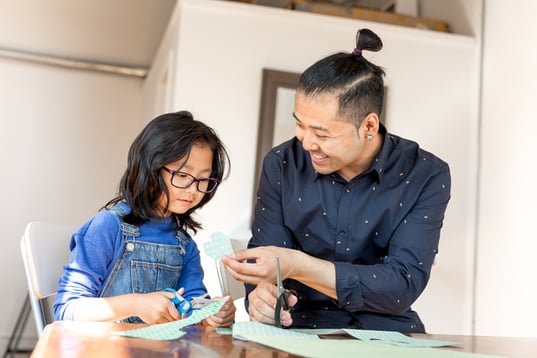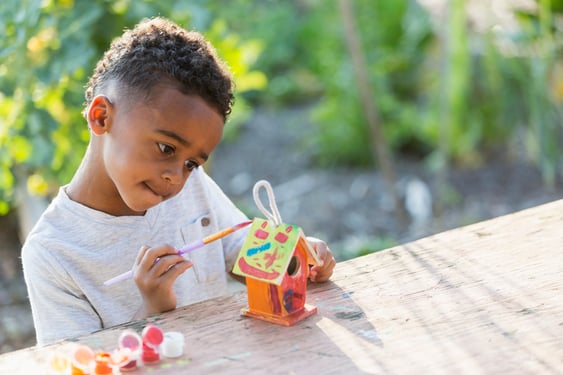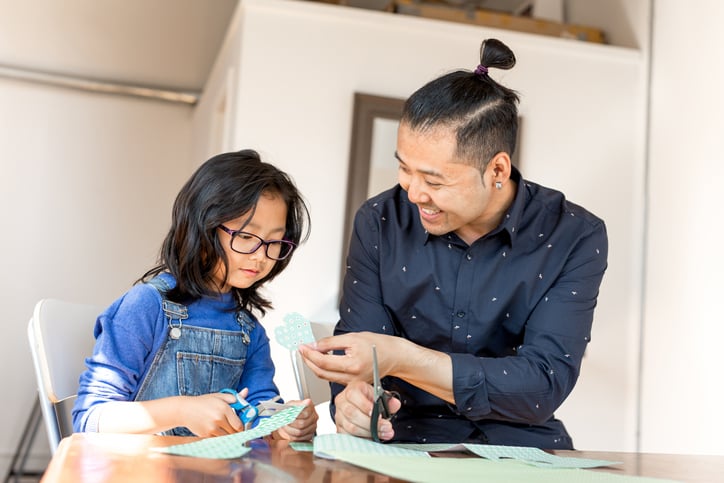Arts and Crafts for Autism Awareness
Arts and crafts projects can increase autism awareness and benefit your autistic child at the same time!
Why do we need to increase autism awareness?
It is estimated that 1 in 36 children are diagnosed as autistic. Autism is prevalent in any community, but there remain many misunderstandings and misperceptions about autism. Helping your community better understand autism leads to greater support from the teachers, service workers, store clerks, police officers, and any member of the public who has not had much direct experience with autistic individuals.
Autism is a spectrum and no two people are the same. Spreading autism awareness is important in helping others understand what autism is and promoting acceptance. As people become aware of autism, they become more compassionate and perceptive of the people in their communities.
How can I involve my autistic child in crafting projects?
Parents, educators, and children can get involved in these fun activities. For autistic children, communication can be difficult. Creativity is a way for children to communicate and express themselves nonverbally. Arts and crafts can be a fun, interactive way to spread autism awareness.
You can involve your child in any aspect of crafting: material preparation, doing parts of the activity, clean up, and discussion! Engaging your child in different mediums and trying out different art techniques can spark interest in crafting projects.

What are the benefits of arts and crafts projects for children with autism?
- Arts and crafts are a nonverbal way to communicate and express oneself through creativity.
- Children can explore different colors, materials, and textures, and use their imagination.
- There can be lots of opportunities for fulfilling sensory needs using a variety of materials.
- This can help with the development of gross and fine motor skills, and visual and spatial skills.
- Children can get practice with a routine: taking out materials, spending 15 minutes crafting, and cleaning up materials.
- Crafting can also increase social skills and concentration abilities.
The following are some fun craft ideas to promote autism awareness and get your child involved:
Fun Crafting Ideas that Help Raise Autism Awareness
1. Autism awareness fabrics
Craft using autism awareness fabric. These are colorful fabrics with puzzle pieces or autism awareness ribbons! There are lots available online or at your local craft store. Some include messages like “I LOVE SOMEONE WITH AUTISM” or “AUTISM AWARENESS!” Incorporating these fabrics into your crafts is a wonderful way to prompt a conversation about autism.
2. Displays
Making a visual display, such as a bulletin board in a local community center or a mural is a colorful way to brighten up your town and spread awareness. Invite friends and neighbors to participate and learn about autism. Artwork or designs are a wonderful way to spark a conversation.
3. Wearable Awareness
Bracelets, t-shirts, hats, or stickers are wearable ways to spread awareness. Incorporate “Autism Awareness,” messages, puzzle pieces, and ribbons to spread a message while you’re walking around your local grocery store or driving around town.

For Parents and Educators
-
Wreath or door decor
Spread autism awareness by decorating your home or classroom door with a wreath or decor that promotes autism awareness. Craft a wreath using rainbow tulle, painted puzzle pieces, ribbons, and autism awareness fabric. A colorful wreath can send a powerful message; for added measure, on a piece of cardstock in the center, write a message relating to autism. Some ideas include “Grow your awareness,” “Light it up blue!” (the slogan for autism awareness month), or “We’re all part of the puzzle.”
-
Autism awareness bulletin board
Creating a bulletin board in your home, church or classroom is a way to create a sense of welcoming and understanding in your space. Start with puzzle piece cutouts and write words that describe your autistic loved one (adventurous, smart, funny, etc.). Piece the puzzle pieces together to create a board that captures everything special about autism. Add pictures of loved ones, stickers, or textures (pipe cleaners, beads, feathers) for added color.
-
Part of the puzzle shadowbox
Do you have someone special in your life who has supported your autistic child or student? Family, friends, teachers, or caregivers? Remind them that they’re appreciated and “part of the puzzle” with a shadowbox. Shadowboxes are small cases that are larger than a typical picture frame. Inside the shadow box, paste a photograph of someone special with your child. No picture? Write a kind quote about what they mean to your family or classroom. Paste puzzle pieces around the image and sprinkle extra pieces into the shadowbox for a memorable gift.
For the Kids
-
Play-Do pieces
Buy puzzle-piece-shaped cookie cutters. These can be found in your local grocery store, craft store, or online. Next, choose your moldable dough. Some families prefer to make their own play-dough or it can be store-bought. Add some food coloring or glitter to your dough for added effect. Then, roll it out and use your cookie cutter to create puzzle piece shapes. Depending on the type of dough, follow instructions to either bake it or leave it out to dry. When finished, your solid three-dimensional puzzle pieces can be used to build, for decor, or as ornaments or door hangings. Get creative with them!
-
Autism awareness photo frame
Grab a blank photo frame from your local craft store or create your own with scissors and cardboard. Using an old puzzle, paint the pieces rainbow or whatever colors you prefer. Add some glitter, puffy paint, or chalkboard paint for an added sensory aspect! Once dry, glue the puzzle pieces around the frame. Include a picture of your autistic child or one with the whole family. Display somewhere central at home.
-
Puzzle piece flower craft
Use a stack of puzzle pieces and decorate away! Use bright markers, crayons, or paint to make for some colorful flower petals. When dry, grab a piece of paper and draw a circle in the center. This will be the center of your flower. Around the circle, paste your puzzle pieces - these are the petals. Add a pipe cleaner stem and decorate the background as desired.

Tips for Getting Your Child Involved
Arts and crafts should be a fun, enjoyable activity. But if your child isn’t naturally inclined to participate in art activities, here are some tips for motivating them to get involved:
-
Direction
You don’t want to make creative time feel like a chore; likewise, if left without solid direction, your child may feel confused. Depending on your child’s needs, provide an appropriate amount of structure to the activity. Using a finished product as an example can be motivating and helpful. If your child benefits from explicit instruction, creating a “to-do list,” checklist, or set of sequencing cards that go over the steps to an art project will guide them. Not all projects will be finished quickly, so allowing appropriate breaks and respecting your child’s attention span for participating will help them understand that this low-stakes activity is meant to be fun! -
Finding the right medium
Markers, paints, clay, pom poms… the list goes on! Autistic children tend to have specific sensory needs. While your child may not respond to drawing with markers on paper well, they may be motivated by using whiteboard markers and tracing magnets. Finding the right medium and the right tools is key to promoting engagement in arts and crafts activities with your child. In learning what tools are best for your child, introduce one at a time so that you do not overwhelm them. Pay attention to how they interact with the materials and the length of time they stay interested in using a specific material. This will give you an idea of which works best for your child. -
Fun
Remember, arts and crafts should be a time for creativity, self-expression, and exploration. If your child appears stressed or anxious by the activities, prompt as appropriate and allow frequent breaks. Sometimes, it’s about the process rather than the product. Allow your child an opportunity to explore materials and techniques freely, even if they do not produce a finished piece that is quite what you had in mind.
This article was based on the following research and information sources:
https://blog.stageslearning.com/blog/autism-art-therapy
https://carmenbpingree.com/blog/art-therapy-activities-for-autism/
https://study.com/academy/lesson/art-therapy-for-children-with-autism-benefits-techniques.html
https://www.autismspeaks.org/blog/why-autism-awareness-understanding-and-acceptance-important-us





